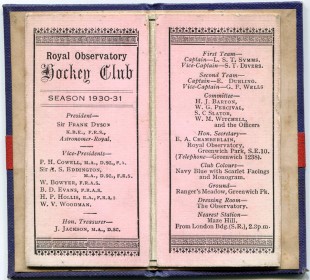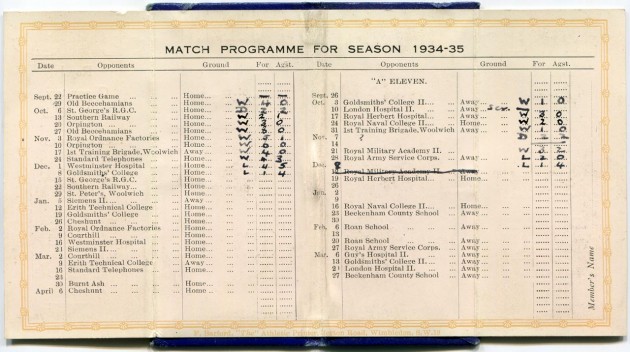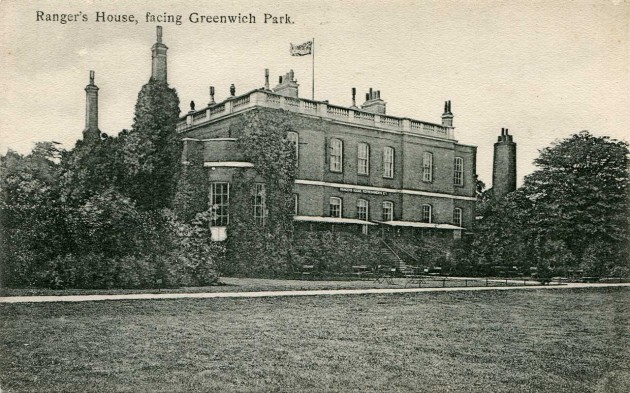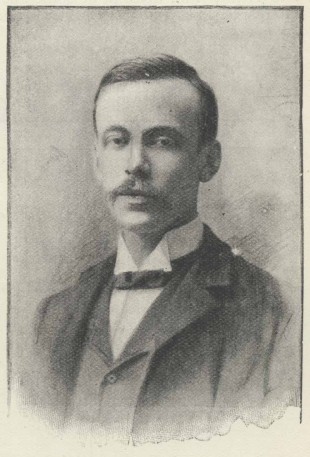…where east meets west
- Home
- Brief History
- The Greenwich Meridian
- Greenwich
(1675–1958) - Herstmonceux
(1948–1990) - Cambridge
(1990–1998) - Outstations (1822–1971)…
- – Chingford (1822–1924)
- – Deal
(1864–1927) - – Abinger
(1923–1957) - – Bristol & Bradford on Avon
(1939–1948) - – Bath
(1939–1949) - – Hartland
(1955–1967) - – Cape of Good Hope
(1959–1971)
- Administration…
- – Funding
- – Governance
- – Inventories
- – Pay
- – Regulations
- – Royal Warrants
- Contemporary Accounts
- People
- Publications
- Science
- Technology
- Telescopes
- Chronometers
- Clocks & Time
- Board of Longitude
- Libraries & Archives
- Visit
- Search
The Royal Observatory Hockey Club (ROHC)
Formed in 1893, the Royal Observatory Hockey Club was the most enduring of the Observatory’s Clubs and Societies. Although membership was originally restricted to members of the Observatory Staff, it was later widened to include members of staff from the Nautical Almanac Office.The account below of the Greenwich Years is a slightly abridged version of an article written by William Witchell and published in 1951 in The Castle Review, the Journal of the Royal Observatory Sports and Social Club. It has been kindly provided by George Wilkins. Witchell was a keen Hockey player and worked at the Observatory for 54 years from 1894 until his retirement in 1948. As originally published, the article was spread across six editions of the Journal and unillustrated.
The National Maritime Museum has in its possession several photographs of the hockey team. These are available to view online as follows.
The Royal Observatory Hockey Club, 1893–94
The Royal Observatory Hockey Club, 1896–97, 1927–28 & 1934–35 (Negative numbers H6479, H6480 & H6481)
After the Second World War, the club ceased to exist in its own right, becoming instead part of the ‘Royal Observatory Social and Sport’s Club’ which was formed at Herstmonceux in 1948. The all male teams were replaced by mixed teams and women’s teams. Games were played on the sports field to the east of the Castle.
Almost as far back as living memories can reach, there have been social organizations of the staff of the Royal Observatory: cricket, lawn tennis, bowls, photography, swimming, rambling – each at some period had its devotees associated more or less formally as a Club. There have even been staff magazines in the past – short-lived it is true. But the organization which far beyond all others secured the enthusiasm of its members, and maintained an enviable continuity, was the Royal Observatory Hockey Club.
In its heyday it was recognised as among the best known London Clubs, and could field an eleven capable of meeting on equal terms all but the half dozen or so really front rank ‘Varsity’ fed sides of the metropolitan area.
A Cricket Club had been formed in 1892. At the end of its second season it showed signs of languishing, as so often, from the lack of a private ground for match playing and, of course, of the means to procure one. As a possible means of holding the members together, some form of winter sport was proposed – but what? Association Football? Rather commonplace and, with the existence ‘Old Boys’ Clubs likely to lead to divided loyalties! Rugby? – the ground difficulty again! Lacrosse? – a Canadian importation rumoured to be dangerous and. already declining! Hockey then? At that time hockey under unified rules was coming into prominence, the All England Hockey Association having been formed a few years earlier.
So on the recommendation of Chief Assistant H.H. Turner, (soon to become Savilian Professor of Astronomy) hockey was chosen, and the Club was definitely launched at a staff meeting on October 16, 1893.
The Club’s first captain was H. H. Turner, the first secretary Albert Walter, later Director of the Mauritius Observatory and subsequently Director – and largely creator – of the British East Africa Meteorological Services.
It had no ground, no colours, no match list, and no experience – though it painfully gained some of the last named during the few scratch games which were got together as the season progressed.
The writer of these notes was present at the first annual meeting of the Club, being the youngest and newest member of the staff. A new captain, Chief Assistant F.W. Dyson, was chosen to succeed Professor Turner who had left the Observatory for his Oxford post, and a new secretary, W. Bowyer, (later head of the Time Department) to replace Walter, whose experiences did not encourage him to continue in office.
The time-honoured colours – navy-blue shirt with scarlet collars and cuffs – were not adopted until the third season, which season also witnessed the appearance of the Club's first printed fixture list.
[Click here to view fixture lists for other years]
The Observatory staff in those days was sharply divided into two categories – established Assistants and temporary Computers. ‘Temporary’ was interpreted in a very literal sense, for members of the latter class were liable to discharge at age 23 [25?]. They were of course, all male, and, the effect of these conditions was to ensure a steady flow of fresh young blood into the Club.
An immensely vitalising feature of the Club throughout its existence was the regular mid-week practice game. To facilitate this, early closing was officially permitted during the winter months, and he was a rash youth who declined the opportunity to learn the game thus put before him – the social penalties were severe! Rapid progress of the neophyte was usually an immediate consequence.
An annual event which was sustained for a succession of years – until, in fact, the disparity in age and numbers became too marked – was the match “Staff v. Computers”. As may be imagined, rivalry was inevitably pretty keen in these tense games. The present writer was told in his early days that the first staff side contained, besides Turner, such notable figures as the; Astronomer Royal (Christie) then only 48 years old, Maunder (wearing a full beard) and Crommelin (who then sported only a rather fierce moustache) but he cannot vouch personally for this.
It was soon plain that the class of matches to be obtained would not much improve until the Club joined the Hockey Association and could run two teams. A private ground was almost equally necessary. The first attempt to secure one was something of a fiasco. A field was hired at a low figure from a farmer at Kidbrook, but when he refused to allow the grass to be cut, in consideration of his cattle, the arrangement fell through and one end of a cricket field was rented instead. This field was soon afterwards built over and the Club was compelled to make do with a rough pitch on Blackheath.
When the Kent County Hockey Association was formed in 1898, the ROHC was one of the founder members and had a representative on the selection committee – P. H. Cowell, the Club’s captain.
An interesting and amusing game played in the late 1890’s [early 1900s?] here comes to mind. Mrs. Cowell was a leading member of the Blackheath Ladies’ Hockey Club. In order to test relative capabilities of the sexes she undertook to match the strongest obtainable ladies side of Kent County players against an Observatory side on equal terms. The game took place on a Boxing Day morning on the Blackheath Ladies Ground. Ankle-length skirts were then ‘de rigueur’ of course. At half time the Observatory had scored seven goals and the Ladies, thoroughly exhausted, nil. The latter then naively proposed that the forward lines should be exchanged! The resulting “mixed” game disposed, once and for all, of any favourable views about this type of hockey which the writer (who took part) may have had!
In 1903 permission was obtained to play Club matches on a fine stretch of turf in the newly formed Ladywell Recreation Ground, Lewisham. This was a turning point in the Club’s history. Home matches could be arranged with really good class opponents and the Club’s reputation increased proportionately. There had been one or two unsuccessful applications for permission to play in Greenwich Park, but news of the appointment of a fresh Bailiff of the Royal Parks encouraged another attempt, and at last the Club received permission to play in the ancient Park itself - on the area known as Ranger’s Meadow – then recently thrown open to the public. But the turf proved to be old and tough and so springy that rolling had little or no effect.
There was naturally considerable disappointment at the anticlimax to years of anticipation. However, after two difficult seasons, a providential occurrence changed the outlook completely. The Royal Naval College lost its sports ground to builders and it too obtained permission to use part of Ranger's Meadow – for Rugby matches.
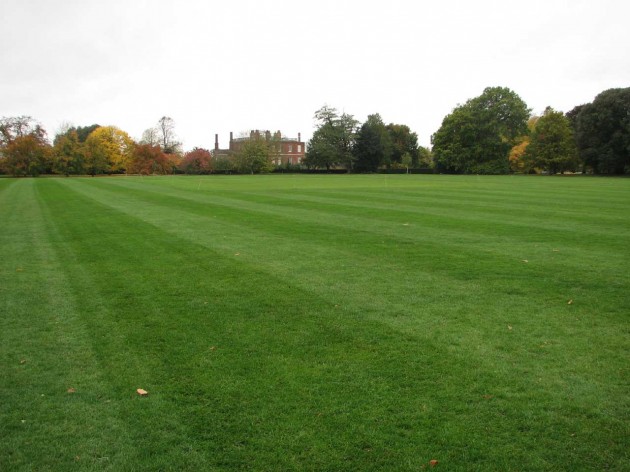
The Ranger's Meadow, now known as the Ranger's Field, is still used for cricket matches. In this photograph, taken in October 2015, the cricket square can be seen in the middle distance with the Ranger's House behind
With the College influence available and the Superintendent of the Park helpful it was somehow arranged that the whole of Ranger’s Meadow should be levelled and returfed at a cost of several hundred pounds (but at no cost to the Observatory).
Hereafter, for many years, the Observatory Hockey Ground was accounted one of the smoothest, driest, and certainly the most picturesque in the London area. Scores of exciting matches have been played on it in the presence of crowds of cheering, not to say critical, spectators.
At first the visiting teams had to be accommodated in the adjoining Ranger's House which had been taken over by the London County Council and adapted as refreshment and dressing rooms for players on their Blackheath pitches. Subsequently, the kindness of Sir William Christie in permitting the Club’s guests to “change” within the sacred precincts of the Observatory itself, completed the amenities which could be offered; and from 1907 the Royal Observatory Hockey Club felt qualified to stand with the best.
The fixture lists for the ensuing years showed a satisfactory maintenance of the standard of matches played; but players in the London area were now so numerous that many of the leading clubs regularly put four and even five teams on the field. These clubs were naturally disinclined to fix with a two-team club and so the front rank ceased to be attainable. Exceptionally, however, a ‘first division’ match was secured by a chance vacancy. At this distance of time club names will probably convey little to readers, but Bromley, Croydon , Ilford, Tulse Hill were leading sides met and defeated under these circumstances, to their own great surprise.
The Club had early become the prime mover of social gatherings organised by the staff. An annual supper was held for some years soon after the conclusion of the playing season, and enjoyable whist drives were arranged from time to time during the winter months. The end of the twenty-first season called for a special coming-of-age celebration. A supper, preceded by whist, was arranged at the famous riverside Trafalgar Hotel, to which as many of the original members as could be expected to attend were invited – and came.
The function was destined to follow a long-sought match with the redoubtable Kingston Grammar School Old Boys' Club. This Club, it should be explained, was entirely recruited from old boys of a school notorious as a nursery of county and international hockey players. The Observatory's contact with the school eleven, nearly twenty years earlier, had resulted in a stinging defeat by 13 goals to 2, but in mitigation it could always be urged that the winning side contained three senior boys in the forward line who, a little later, each played, for England - to say nothing of the master who coached the team.
Sad to relate, the Kingston Old Boys proved too strong for the R.O. on this momentous occasion also, and it was a somewhat tired, though by no means, dispirited, eleven that joined the company to spend a jovial evening. The Astronomer Royal, as President, was supported on the right by Professor Turner, on the left by Professor Eddington, and practically all the senior staff were present. After an excellent meal, toasts, songs, and the swapping of reminiscences, the company broke up in hilarious mood, highly optimistic about the next season,
Within four months the Great War was upon the country! Most of the young members soon joined the forces – five or six did not come through – and the Club was suspended “for the duration”.
It was during the war that the first distinct warning of trouble ahead had appeared – in the shape of “lady computers” – though some years earlier the effect of creating a certain number of established posts for male computers was becoming noticeable. In fact, the average age of the teams had been gradually increasing!
Soon after the end of the war it was decided that the broken threads should be picked up as far as possible, and a good fixture list was obtained for the season 1919–20. But the officers of the Club now began to rely over-much upon its older and more experienced members to man the first eleven, thinking thus to keep the fixtures and maintain the prestige which it had gained by 1914.
One can see by the light of after events that this was an unsound policy. In the end it resulted in the virtual separation of the Club into two sections, not altogether devoid of rivalry. Nevertheless, the first few seasons of the Club's revival proved to be among the most successful of all. Moreover, the County team usually contained one, and occasionally two, Observatory men in the forward line.
In 1919 a breast badge was added to the Club shirt, consisting of' the letters R.O.H.C. in scarlet monogram, surmounted by three white stars in a horizontal line. It was at first intended that the badge should be awarded as “colours” to accepted first-team players, but the existence of a distinction of this kind did not meet with general approval and the idea was dropped.
A memorable function took place on October 10, 1923, when the 30th anniversary of' the foundation of the Club was celebrated by a dinner in the famous Octagon Room of the Observatory. The occasion was utilised to bid farewell to Chief Assistant Spencer Jones who was leaving England for South Africa to become His Majesty's Astronomer at the Cape Observatory, and also to Benjamin Evans, generally considered the most brilliant of all the Club’s players, who was returning after triennial home-leave to his post at Hong Kong Observatory (he subsequently became Director).
Many successful seasons still remained before the second Great War, and new staff conditions put an end to any hope of continuing the Club at Greenwich. The present writer, however, prefers not to carry its history further; there are others equally qualified to do so.He may perhaps be permitted to refer to a few outstanding personalities of the earlier years, well knowing that, in the words of Shakespeare’s Dogberry, “comparisons are odorous”. The Club’s third captain, Dr. Philip Cowell (who later became Superintendent of the Nautical Almanac Office) was probably the fastest forward it ever had – he played outside left – though D. J. Edney (ET. Barker’s immediate predecessor as Secretary of the Observatory) who usually played centre-forward, was a close second.
W.H. Bryant, the Club’s fourth Captain (latterly Superintendent of the Magnetic and Meteorological Department) was a sturdy, if unorthodox, back who insisted on playing without shin-guards (and suffered accordingly) and whose high-pitched “Play up R.O.” cheerily emerged from every rough-and-tumble of which he was the centre.
W. W. Burkett , the Club’s fifth captain, was a powerful attacking forward. A sabre expert, champion fencer in the Territorials, he rose from private to brigade-major in the first Great War, won the Military Cross, and, leaving the Observatory for the Air Ministry, ultimately attained the post of Deputy Director of' Civil Aviation.
Benjamin Evans, sixth captain, was undoubtedly the deadliest shot and cleverest individualist the Club produced. He could be relied upon to score from any angle with a deceptive lifting ball almost impossible to judge.
Paul Showell was a brilliant and fearless goalkeeper and was the first man in the Club to gain County honours. Four other members, all forwards, subsequently attained this distinction – B. D. Evans and his cousin W. G. Davies (each many times), J. Shepperd and W. Palmer.
Of the writer's own playing career it may be said that it began in 1894 and ended in 1931. During this long span he played in 680 first eleven matches - usually at centre half back – and probably in more than 750 practice games, without meeting serious injury – surely an “all time” record. He was Secretary of the Club from 1906 to 1928. It was his good fortune, as the seventh captain, to govern the Club during ten of its most successful seasons and he remained Secretary for two years after laying down the captaincy.
In this brief sketch it has only been possible to touch upon a very few of' the incidents which crowd into the mind’s eye as it looks back across almost two generations. Details of individual achievements have been deliberately avoided as being of' little significance today and as tending inevitably to reduce the sketch to a bare catalogue of events. But it is the writer’s hope that sufficient has been set down to assure the present followers of this grand winter game at the Royal Greenwich Observatory that they are in the line of an honourable tradition and one which brought considerable prestige in sport to their ancient institution in "former days".
W.M. Witchell.
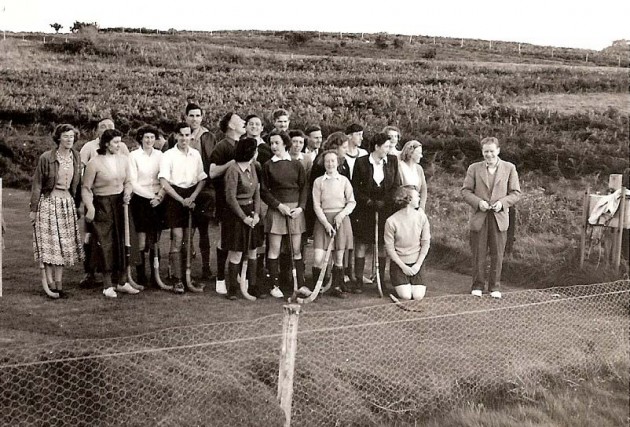
Members of the Hockey Club c.1955. Individuals (identified mainy by George Wilkins) from left to right (with maiden names in brackets), are: 1.'Flip' (Restorick) Rhodes (N): 2. Albert Carter (N): 3. Angela (James) Jarrett (N): 4. Patricia (Scott) Scales (M): 5. Phillip Gething (M): 6. George Wilkins (N): 7. Ken Blackwell (M): 8. Virginia (Knight) Long (N): 9. Derek Harragan (N): 10. Margaret (Newman) Teague (S): 11. John Lipscombe (C): 12. Winnie (Barton) Boorman (N): 13. Alan Philcox (C): 14. 'Scrap' Cynthia Ryall (C): 15. Barbara Strevett (Carey) ? (Office): 16. Not known: 17. Jean Morris? (Office ): 18. Not known: 19. Mavis (Gibson) Wayman (N). 20. Not known. Referee: David Evans (Head of Chronometer Workshop). (C) = Chronometer Dept, (M) = Meridian Dept, (N) = Nautical Almanac Office, S= Solar Dept. Photo courtesy of Phillip Gething
© 2014 – 2025 Graham Dolan
Except where indicated, all text and images are the copyright of Graham Dolan
